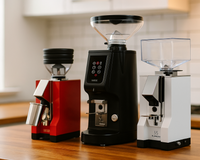Why Your Rocket Steam Wand Is Not Frothing Well: Troubleshooting Tips and Fixes
As a coffee enthusiast (and Rocket Espresso machine owner), there's nothing quite as disappointing as a Rocket steam wand that's not frothing well. Whether you're a barista or a home brewer, getting the perfect froth is essential for making the perfect latte, cappuccino, or any other milk-based espresso drink. Fortunately, there are several reasons why your Rocket steam wand might not be frothing well, and in this blog post, we'll explore some of the most common issues and provide you with tips and fixes to get your steam wand frothing like a pro again.

Low P? Here's why your Rocket may have low steam pressure:
There are several reasons why your Rocket Espresso Machine's steam pressure might be low:
-
Low water level: If the water level in the boiler is low, the steam pressure will be low. Check the sight glass on the machine to make sure the water level is above the minimum mark.
-
Clogged steam wand tip: If the steam wand tip is clogged or dirty, it can restrict the flow of steam and reduce pressure. Remove the tip and clean it thoroughly.
-
Steam wand valve partially closed: If the valve on the steam wand is partially closed, it can limit the flow of steam and reduce pressure. Make sure the valve is fully open.
-
Anti-vacuum valve malfunctioning: The anti-vacuum valve prevents air from being drawn back into the boiler and maintains a constant pressure. If the valve is malfunctioning or clogged, it can cause low steam pressure. Remove the valve and clean it thoroughly.
-
Low boiler pressure: If the pressure in the boiler is too low, it can cause low steam pressure. Check the pressure gauge and adjust the pressure using the boiler pressure adjustment screw.
-
Faulty heating element: If the heating element is faulty, it can affect the steam pressure. Test the element with a multimeter and replace it if necessary.
-
Water pump not working properly: If the water pump is not working properly, it can affect the steam pressure. Test the pump with a multimeter and replace it if necessary.
If you're unable to identify and fix the issue yourself, it's best to contact a professional technician or the manufacturer for further assistance.
Related Article: How to lube the lever of your Rocket Espresso Machine
First, check these to fix low pressure
-
Check the water level: Low steam pressure can be caused by low water levels in the boiler. Make sure the water level is above the minimum mark on the sight glass.
-
Check the steam wand tip: If the steam wand tip is clogged or dirty, it can reduce the steam pressure. Remove the tip and clean it thoroughly.
-
Check the steam wand valve: If the valve is partially closed, it can limit the steam flow and reduce pressure. Make sure the valve is fully open.
-
Check the steam boiler pressure: The steam boiler pressure should be set between 1.0 and 1.2 bar. If the pressure is too low, adjust it using the pressure gauge and the boiler pressure adjustment screw.
-
Check the anti-vacuum valve: If the anti-vacuum valve is malfunctioning or clogged, it can cause low steam pressure. Remove the valve and clean it thoroughly.
-
Check the steam boiler heating element: If the heating element is faulty, it can affect the steam pressure. Test the element with a multimeter and replace it if necessary.
-
Check the pump: If the water pump is not working properly, it can affect the steam pressure. Test the pump with a multimeter and replace it if necessary.
**if your machine is still under warranty it is highly advisable to not perform any repairs or open your Rocket Espresso Machine without speaking to your dealer or authorized repair outfit. Failure to do so may result in a voided warranty or worse, you could potentially damage your machine further.
How to adjust steam pressure on a Rocket:
To adjust the steam pressure on a Rocket Espresso Machine, follow these steps:
-
Turn off the machine and wait for it to cool down completely.
-
Remove the top cover of the machine to access the pressure stat.
-
Locate the pressure stat, which is a small brass or silver box with a wire or tube coming out of it.
-
Use a small flathead screwdriver to adjust the pressure. Turn the screw clockwise to increase the pressure and counterclockwise to decrease the pressure.
-
Turn on the machine and wait for it to heat up to operating temperature.
-
Check the steam pressure gauge to see if the pressure has been adjusted to the desired level. The optimal pressure for steaming milk is typically between 1.0 and 1.2 bar.
-
If necessary, adjust the pressure again by repeating the steps above.
-
Once you've achieved the desired pressure, replace the top cover of the machine and test the steam wand to make sure it's producing the desired amount of steam.
It's important to note that adjusting the steam pressure can be a delicate process, and if you're not comfortable doing it yourself, it's best to have a professional technician or the manufacturer do it for you. Incorrect adjustments can damage the machine or cause safety hazards.
How to check the anti-vacuum valve:
To check the anti-vacuum valve on a Rocket Espresso Machine, follow these steps:
-
Turn off the machine and wait for it to cool down completely.
-
Locate the anti-vacuum valve, which is usually located near the top of the boiler.
-
Remove the anti-vacuum valve from the boiler by unscrewing it counterclockwise.
-
Inspect the valve for any signs of damage or wear, such as cracks or corrosion.
-
Check the valve for any blockages or debris that may be preventing it from functioning properly.
-
Clean the valve thoroughly with a soft-bristled brush and a solution of warm water and dish soap.
-
Reinstall the valve by screwing it back into the boiler clockwise until it's snug.
-
Turn on the machine and test the steam wand to see if the anti-vacuum valve is working properly.
If you're still experiencing low steam pressure or other issues with your Rocket Espresso Machine after checking and cleaning the anti-vacuum valve, it's best to contact a professional technician or the manufacturer for further assistance.
How can I check the heating element?
Notice - this should be done by an authorized professional.
To check the heating element on a Rocket Espresso Machine, follow these steps:
-
Turn off the machine and wait for it to cool down completely.
-
Locate the heating element, which is usually located inside the boiler and can be accessed by removing the top cover of the machine.
-
Use a multimeter to test the heating element for continuity. Set the multimeter to the resistance or ohms setting and touch the multimeter leads to the heating element terminals. If the reading is close to zero, the element has continuity and is functioning properly. If the reading is high or infinity, the element is faulty and needs to be replaced.
-
Check the heating element for any signs of damage, such as cracks or corrosion. If there is visible damage, the element needs to be replaced.
-
Check the wiring connections to the heating element for any loose or damaged wires. Tighten any loose connections and replace any damaged wires.
-
If you're unsure how to test the heating element or don't have the necessary tools, it's best to contact a professional technician or the manufacturer for further assistance.
-
Once you've determined that the heating element is functioning properly, reassemble the machine and turn it on to test the steam wand and ensure the machine is operating correctly.
Note that working on electrical components of a machine can be dangerous and should be done by a trained professional to avoid injury or damage to the machine.















